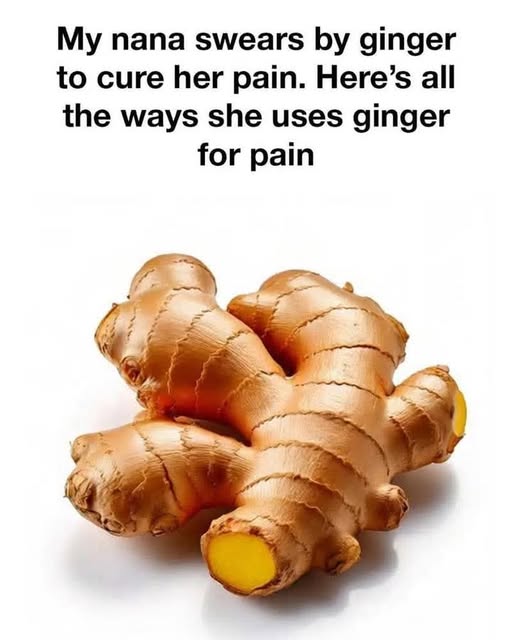I still remember the day my nana collapsed in the middle of her tiny kitchen, a wooden spoon slipping from her trembling hand, the smell of simmering chicken soup filling the air as she sank to the floor. That was the beginning of what she would later call the dark months. Doctors diagnosed her with severe arthritis and nerve inflammation. Her joints were so inflamed she could barely hold a cup of tea, let alone knead her famous dough or tend to her herb garden. Painkillers dulled her mind and made her dizzy. Steroid injections offered temporary relief but came with so many side effects that she feared taking them. She hated relying on prescriptions that seemed to do more harm than good. I watched her slowly retreat from the vibrant, energetic woman who raised me to someone I barely recognized—silent, withdrawn, afraid of movement, afraid of pain.
One afternoon, in her stubborn refusal to give in, Nana reached for something she hadn’t touched in years—ginger. It was something she remembered from her own childhood, passed down from her Cambodian mother. “We didn’t have hospitals where I grew up,” she told me. “We had roots. Ginger root was one of them. My mother boiled it for everything—headaches, stomachaches, swollen feet, broken hearts.” That day, she peeled a chunk of ginger with shaky hands, boiled it in water, and drank the golden liquid slowly. That night, she slept without painkillers. It wasn’t a miracle, not yet—but it was the beginning of a miracle in the making.
Over the next few weeks, Nana began experimenting with ginger in every way she could imagine. Every morning, she would slice fresh ginger and boil it into a strong tea. She added honey and a splash of lemon for taste, and let it steep until the air in the kitchen was thick with spice. “The first cup burns,” she said, “but it’s a good burn. It chases the pain away.” She rubbed homemade ginger oil into her knees every night, made by infusing grated ginger into coconut oil and warming it gently over a flame. She massaged it in slowly, with her eyes closed and her breath steady. After a month, she said her knees didn’t ache quite as much. She could climb the stairs again without crying.
Then came the ginger compresses. She wrapped fresh grated ginger in a cheesecloth, dipped it in hot water, and placed it on her lower back. “This is how we did it during the war,” she told me. “When we didn’t have medicine, we had this.” Her back pain, which had once sent her into spasms, began to fade. I saw color return to her cheeks. I saw her laugh again, the kind of belly laugh I hadn’t heard in months. She even baked banana bread again, with ginger added for good measure.
What stunned me most wasn’t just her recovery—it was the science I discovered as I watched her transform. I dug deep into research papers and found what Nana already knew in her bones: ginger contains powerful anti-inflammatory compounds like gingerol and shogaol. These natural chemicals inhibit the same pathways as nonsteroidal anti-inflammatory drugs (NSAIDs), but without the harsh side effects. It’s been shown in studies to reduce muscle pain after exercise, ease osteoarthritis, and even alleviate menstrual cramps. Some trials compared it favorably to ibuprofen. Nana had found a treatment backed by centuries of tradition and now supported by modern research—and all from a root that costs less than a few dollars per pound.
She didn’t stop there. Nana began using ginger in her food again. Every soup, stew, and stir-fry had a kick. She added it to her rice, her smoothies, her morning oatmeal. She chewed candied ginger when her hands began to tingle or swell. She soaked in ginger baths, where she’d add a few tablespoons of ground ginger to warm water and sit quietly, letting the heat and spice seep into her skin. Sometimes, she’d combine it with Epsom salts and lavender oil for a deeper, more soothing experience. “This,” she said, leaning back with her eyes closed, “is better than any spa.”
The pain didn’t vanish overnight. But it became manageable. Nana went from barely walking to tending her garden again. She grew her own ginger, too—tiny shoots in a clay pot by the window. “Fresh is best,” she’d say. “The older the ginger, the stronger the medicine.” I watched her slowly reclaim her life, not just through ginger, but through the act of healing itself. She felt empowered. She wasn’t waiting for a prescription refill or another appointment. She was taking control, on her terms, with what she trusted.
I began using ginger, too. Not for arthritis—I’m too young for that, at least for now—but for headaches, tension, and sore muscles. I copied her tea recipe and kept a jar of ginger-infused honey in my cabinet. I even started gifting friends homemade ginger balm, packed with beeswax and shea butter. Nana’s story spread through our neighborhood like wildfire. Elderly neighbors knocked on her door asking for advice. One even stopped taking her anti-inflammatory pills altogether and switched to ginger compresses. It was as if something ancient had been rediscovered, something that had been there all along but forgotten in the race toward synthetic solutions.
I asked Nana once, “Do you think ginger cured you?” She looked at me, thoughtful. “Not cured,” she said. “But it gave me back my hope. And when you’re in pain, that’s sometimes more important than a cure.”
Now, every time I see ginger at the market—whether fresh root, powdered, candied, or in tea bags—I think of her. I think of how she fought her pain with something simple and ancient, something that grew from the earth. And I think of the countless others who might be out there, suffering silently, unaware that relief might be as close as their kitchen.
Pain is universal. Whether it’s physical, emotional, or spiritual, we all carry it. But sometimes, healing doesn’t come in the form of a miracle pill or a high-tech machine. Sometimes, it comes wrapped in papery skin, with a golden core and a spicy, earthy bite. Sometimes, healing is ginger—grated into tea, pressed into oil, or simply held between fingers like a lifeline. And sometimes, the wisdom of grandmothers holds more truth than all the medical textbooks in the world.

